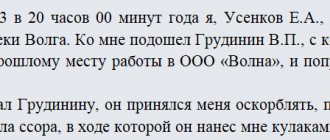Types of criminal prosecution
The classification of types of criminal prosecution is based on public and private principles.
The main features of a separate type of criminal prosecution:
- the interest pursued by the accuser;
- legal status of the subject of the accusatory function.
Types of criminal prosecution:
- private prosecution - carried out in private interests by a private person who has suffered from a crime;
- public accusation – the subject of law is the state or society in the name of public interests and abstract good;
- private-public – this type combines private and public accusations.
Private criminal prosecution plays a minor role in modern criminal proceedings and is carried out in a narrow category of criminal cases. Criminal Procedure Code We have already completed our thesis
Criminal procedural acts are allowed in more detail by private prosecution on three grounds: minor harm to health (part 1 of article 115), beatings (part 1 of article 116), slander (part 1 of article 128.1). In cases of private criminal prosecution, initiation and proceedings depend on the criminal act and the will of the victim.
Cases when filing a private complaint is possible
When the court hearing a case at first instance decides certain procedural issues by making a ruling, it can be appealed. But for this, two basic conditions must be met:
- Filing a private complaint is provided for by law. For example, if the case is suspended, or if the claim is left without consideration.
- The appealed ruling interferes with the progress of the case.
A person who has expressed a desire to appeal the determination must meet the deadline allotted for this, namely fifteen days . But the Code of Civil Procedure of the Russian Federation may also establish other deadlines, which should be explicitly stated in the article. Then the deadline from the article for appealing the court decision applies.
Who do they file personal files against?
This question can be answered unequivocally only in relation to civil servants: for all, as required by law.
Since maintaining personal files is not necessary for private entrepreneurs, they themselves can decide which employees to keep this documentation for, and which ones can do without such detailed personnel records. Some managers who practice this system prefer to keep personal records for all personnel in order to systematize data for each employee. But some, in order to save time, organize the management of personal files only for certain categories of employees.
For employees of what positions are personal files usually opened?:
- management;
- deputy managers at various levels;
- key specialists;
- employees bearing financial responsibility;
- personnel reserve, etc.
FOR YOUR INFORMATION! It is advisable to open a personal file for such employees, regardless of the form and time of his employment - he works part-time or at his main job, under a fixed-term employment contract or on a permanent basis.
Less often, positions are provided with personal records for which educational, qualification or other special requirements are not provided, for example, cleaner, watchman, janitor, etc.
How to properly file a personal file
IMPORTANT! Recommendations for managing personal affairs from ConsultantPlus are available here
Business documentation should be maintained in accordance with generally accepted requirements, even if they are not enshrined in law, this increases the efficiency of its use. This responsibility is assigned by internal regulations to a specific employee, most often a representative of the enterprise’s personnel service.
His responsibilities are:
- initial establishment of a personal file;
- adding new records and documents to it;
- seizure of temporary storage documents that have expired or are no longer valid;
- if necessary, certification of copies;
- internal inventory of documents included in the case;
- scheduled check of the status of personal files;
- annual familiarization of the employee with his personal file against his signature;
- storage of files;
- placing irrelevant files in the archive.
IMPORTANT! An employee conducting personal affairs must have authorized access to personal data of employees.
Personal file cover
A personal file is a collection of a large number of documents, which dictates the necessity of some way to easily find the necessary information. It is customary to systematize information from a personal file on the title page (cover). It is convenient to use the requirements for cover design, which have remained unchanged since July 17, 1972 (GOST 17914-72):
- space is left on top for the future archival stamp;
- The full and abbreviated name of the organization is located at the top center;
- The structural unit is indicated below (you need to leave a few lines to reflect information about a possible change of department);
- case number (according to the nomenclature adopted by the company);
- last name, first name and patronymic of the employee against whom the case is being opened;
- the lower right corner carries information about the timing of the case: the opening date, that is, the day of hiring, and the closing date (dismissal order);
- The number of sheets in the file at the time of the inventory is written here;
- case retention period.
Description of the personal file
All documents that fall into that folder must be numbered and filed, and also take their place in the list of documents.
The list of documents in the personal file can be located on the inside of the cardboard cover of the folder or be filed last.
At the top of the sheet intended for this purpose, the name is written (“LIST of documents of the personal file”), then the employee’s full name is written in the nominative case. It is convenient to keep the inventory in the form of the following table.
| № | Index | date of issue | Heading | Number of case sheets | Date included | Note |
| Document serial number | According to internal nomenclature | Indicated by Arabic numerals | Document's name | Depending on the location in the case | Day of placement in personal file | Different marks, for example. original or copy. |
After the table, the number of documents and sheets included in the inventory is written in words and numbers. At the end there is the date of the inventory and the signature of the performer with a transcript.
Deadlines for filing a personal file
As a rule, a personal file is opened for an employee for the first time after he has signed an order for his employment and has become familiar with this order.
The personal file is maintained, supplemented with documentation, and updated throughout the entire time the employee works for this employer. Unlike personal affairs in the public service, it is not customary for private entrepreneurs to disclose personal affairs when changing jobs. The relevance of a personal file lasts until it is transferred to the archive due to the dismissal of an employee.
What documents are included in a personal file?
The composition of personal files, as well as the procedure for formation, for private entrepreneurship is not fixed at the legislative level, but it must be properly prescribed in the local act of the company.
Documents that usually belong to a personal file can be divided into several groups:
- Primary documentation for hiring. This includes those documents that employees provide upon employment, and those that are filled out and entered directly during registration. It can be:
- summary;
- documents on education and qualifications;
- copies of identification documents (passport, SNILS, identification code, if any);
- recommendations or reviews from previous employers (if necessary);
- a document or a copy thereof regarding military registration (if available);
- certificate of no criminal record (needed when applying for certain positions);
- medical examination data;
- completed application form (if provided);
- employment application;
- a copy of the admission order;
- concluded employment contract, etc.
- Papers that appeared in the process of working in this position. They may reflect the employee's professional achievements or his social dynamics. These may include:
- various qualification certificates;
- driver license;
- marriage or divorce certificate, if these events occurred during employment;
- birth certificates of children (same justification);
- job description;
- additional agreements concluded (if this was done);
- a copy of the agreement on financial responsibility (if the position provides for it);
- certification certificates;
- data from regular medical examinations;
- documents establishing medical restrictions or disability (if this happened during work);
- copies of orders about internal changes in position (transfer, promotion, demotion, etc.);
- data on disciplinary sanctions and work incentives;
- leave requests;
- reports, explanatory notes, memos, etc.
- Documents confirming the employment relationship with this employer. Before the case is dismissed, it must be properly completed. The latest documents in the personal file folder may be:
- resignation letter;
- a copy of the dismissal order;
- documents on dismissal due to external transfer;
- employee's death certificate.
Receiving a photo from an employee for storage in a personal file is not considered processing of biometric personal data. After all, the personnel officer will not establish a person’s identity from a photo, this is just an element of the questionnaire. Therefore, obtaining a photo for these purposes is considered as processing (collection) of ordinary personal data, such as passport data, address, etc. Is it necessary to obtain consent for processing in this case? View answer
Managing personal affairs
The procedure for maintaining personnel documentation must be set out in detail in the relevant Regulations adopted by the company. It may provide for a number of accounting procedures:
- Registration. In large organizations, a special journal or book is created to record personal affairs. Each new case is entered into it under a certain number (code), the same sequence of numbers is affixed to the folder with the case itself. The journal may also contain the following information about a personal file:
- Full name of the employee;
- establishment date;
- closing date;
- date of transfer to the archive.
- Adjustment . It is necessary if, during the employment process, the employee’s personal data has undergone significant changes: place of residence, social status due to marriage or divorce, change of surname, etc. Changes are made based on the attachment of relevant documentary evidence (copies of marriage certificate, birth certificate, etc.). Only a responsible employee appointed by a special order, or another officially authorized to replace him, has the right to make changes.
- Storage. Since personal data is confidential information, folders must be stored so that they cannot be accessed by unauthorized persons. Typically a safe or locked cabinet is used for this purpose. Only files of active employees should be kept. After dismissal, the employer retains the case for some time (he sets this period himself; in the civil service, if the case is not transferred to another body, it is 10 years).
- Transfer to the archive. The case of the dismissed employee must be closed and, upon expiration of the internal savings period, transferred to archival storage. To transfer, you need to fill out a certification sheet , where final information about the state of your personal file is entered. This sheet is filed at the end of the folder. From the moment the file is transferred to the archive, it will be stored there for 75 years if it belonged to an ordinary employee, and permanently if it belonged to a manager.
NOTE! If an error, inaccuracy or consequence of a change is corrected, this should be done by analogy with work books: cross out the incorrect one with one line, write the correct version at the top, and in the margins put a note about the correctness of the correction and its date.
What form should be used to keep a log of personal files of employees ?







